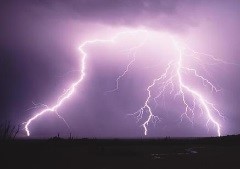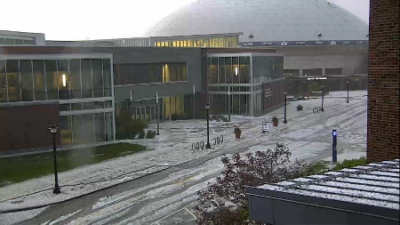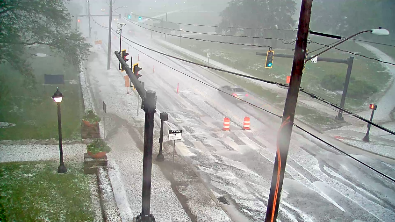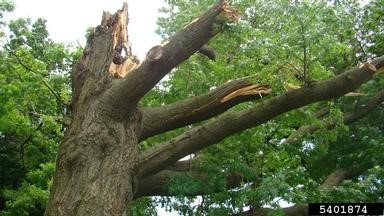
SEVERE WEATHER
Severe Weather 
Thunder/Lightning, Hail, High Winds
Before: Severe Weather Preparation
Severe weather can strike at any time. Signup for weather alerts on your mobile device, such as the FEMA app https://www.fema.gov/mobile-app and Weather.gov https://weather.com/apps. Make sure you enable the notification features on both your phone and within the app itself.
- Ensure you are signed up for UConnALERT.
- Download the FEMA App to receive real time weather alerts from the National Weather Service.
- Visit: http://www.fema.gov/mobile-app
- Once you download the mobile application, enter your county into the “Weather Alerts” section of the app. You can enter up to 5 locations. You can view a map of Connecticut counties here.
Understanding Severe Weather Alerts
The National Weather Service (NWS) issues a number of Watches, Warnings and Advisories to alert the public about severe weather events.
Be Prepared:
- Severe Thunderstorm Watch: A Severe Thunderstorm Watch is issued when severe thunderstorms are possible in and near the watch area. Winds 58 mph or higher and/or hail 1 inch or larger are possible in a severe thunderstorm. Secure items outdoors that may blow around in high winds. Stay informed and be ready to take action, including seeking shelter inside a sturdy building, away from windows.
- High Wind Watch: Sustained, strong winds are possible. Secure loose outdoor items and adjust plans as necessary so you're not caught outside. NWS offices issue this Watch based on local criteria.
Take Action:
- Severe Thunderstorm Warning: A Severe Thunderstorm Warning is issued when severe thunderstorms is happening or is imminent in the warning area. Severe thunderstorms have wind 58 mph or higher and/or hail 1 inch or larger. Seek shelter inside a sturdy building, away from windows.
- High Wind Warning: Sustained, strong winds with even stronger gusts are happening. Seek shelter. If you are driving, keep both hands on the wheels and slow down. NWS offices issue this Warning based on local criteria.
- Wind Advisory: Strong winds are occurring but are not so strong as to warrant a High Wind Warning. Objects that are outdoors should be secured and caution should be taken if driving. NWS offices issue this Advisory based on local criteria.
- Gale Warning: Gale Warnings are issued for locations along the water when one or both of the following conditions is expected to begin within 36 hours and is not directly associated with a tropical cyclone: sustained winds of 39 to 55 mph or frequent gusts (frequent intermittent gusts lasting a period of two [2] or more hours) between 39 and 55 mph.
- Hurricane Force Wind Warning: Hurricane Force Wind Warnings are issued for locations along the water when one or both of the following conditions is expected to begin within 36 hours and not directly associated with a tropical cyclone: sustained winds of 74 mph or greater or frequent gusts (duration of two or more hours) of 74 mph or greater.
During: Severe Weather Response Actions
During severe weather, monitor local weather advisories via radio or television, mobile apps and the National Weather Service (NWS) webpage for information on the status of the storm and what actions to take. Follow the guidance below for what to do if there is thunder and lightning, hail and/or strong winds. If there is anyone who might need immediate medical assistance, call 911. For non-emergency situations, contact UConn Police at (860) 486-4800 for assistance.
 THUNDER/LIGHTNING
THUNDER/LIGHTNING
30-30 Rule: If thunder is 30 seconds apart, seek shelter immediately. Wait 30 minutes after the last audible thunder, until you resume your outdoor activity.
Lightning: What You Need to Know
- It is not safe to be outdoors when thunderstorms are in the area!
- If you hear thunder, lightning is close enough to strike you.
- When you hear thunder, immediately move to a “lightning safe” facility until the weather clears. A “lightning safe” facility is a fully enclosed building with both plumbing and wiring.
- Concession stands, pavilions, standing under trees, equipment sheds and tents are not considered “lightning safe” and lightning can still strike people within these locations.
- If a fully enclosed building is not available, people should go inside a car or bus and close the windows and doors.
- Stay in the safe shelter at least 30 minutes after you hear the last sound of thunder.
Indoor Lightning Safety
- Stay off corded phones, computers and other electrical equipment that put you in direct contact with electricity.
- Avoid plumbing, including sinks, baths/showers and faucets.
- Stay away from windows and doors, and stay off porches.
- Do not lie on concrete floors, and do not lean against concrete walls.
Last Resort Outdoor Risk Reduction Tips
If you are caught outside with no safe shelter anywhere nearby the following actions may reduce your risk of injury:
- Immediately get off elevated areas such as hills, mountain ridges or peaks
- Never lie flat on the ground
- Never shelter under an isolated tree
- Never use a cliff or rocky overhang for shelter
- Immediately get out and away from ponds, lakes and other bodies of water
- Stay away from objects that conduct electricity (barbed wire fences, power lines, etc.)
If you are driving during a thunderstorm
- If stuck in a car, pull off to the side of the road; avoid parking your car near or under large trees.
- Turn your emergency flashers on
- Turn off the engine
- Place your hands on your lap and do not touch any metallic objects or any of the car’s electronic devices.
- Do not lean on doors, touch the ignition, radio dials, door handles, gear shifts or the steering wheel.
If an electrical wire falls on top of your vehicle
- Use your cellular device to call 911 and remain inside your vehicle until emergency personnel arrive.
- The wire on your car may be live so your car will remain electrified until the electricity to that wire is shut off by the utility company.
- Any metal parts of your car, inside and out, can conduct electricity; you can get electrocuted by turning on the ignition
If someone has been struck by lightning
- For help, call 911.
- Lightning victims do not carry an electrical charge, are safe to touch and need urgent medical attention. Some deaths can be prevented if the victim receives the proper first aid immediately.
- If you know how, give first aid. Do not delay CPR if the person is unresponsive or not breathing. Use an Automatic External Defibrillator if one is available.
- If possible, move the victim to a safer place. Lightning can strike twice. Don’t become a victim.
 HAIL
HAIL
Hail is a form of solid precipitation which consists of balls or irregular chunks of ice that form within thunderstorms. Large hail can cause damage to objects, such as cars, aircraft, homes, and trees. In some cases, they can cause bodily injuries, or in rare cases death. Hail may take on many different shapes and sizes, ranging from the size of a pea up to the size of a softball. In extreme cases they can be even larger. The National Weather Service deems hail one inch in diameter (quarter size) or larger to be severe.
Move inside, stay inside
- Hailstones vary greatly in size, but even small ones—driven by gravity and strong winds—pose a danger to anything or anyone caught in a storm. As a storm approaches, put vehicles in the garage and bring pets inside. If you are outdoors, go indoors immediately.
- Once indoors, close all drapes, blinds, or shades to prevent broken window glass and hailstones from entering your home. If possible, move to a basement, cellar, or other level of the building not directly below the roof. Stay indoors until the storm has passed.
When driving and a hailstorm starts
- Stay inside the vehicle. Hail falls at fast speeds, and it can cause injury.
- When safe to do so, pull over to a safe place, such as an overpass. Driving compounds hail's impact with your car. Avoid ditches due to possible high-rising water.
- Keep your car angled so the hail is hitting the front of your car. Front windshields are reinforced to withstand forward driving and pelting objects. Side windows and back glass are not, so they are much more susceptible to breakage.
- Lie down, if possible, and keep your back to the windows. If you have a blanket, cover yourself with it to prevent possible debris from hitting you.
 HIGH WINDS
HIGH WINDS
Severe wind storms are dangerous and difficult to predict with some gusts coming with little or no warning. It is imperative that students, faculty and staff pay close attention to local news and the National Weather Service (NWS). Construction project supervisors should pay attention to warnings as projects may need to be halted and construction equipment and materials may need to be secured. The NWS does their best to send out warnings and notifications as soon as local data is available.
Monitor weather for severe storm
- If there are thunderstorm warnings or if the sky looks ominous, it is important to immediately check the weather. Responding quickly to warnings is the most important step in keeping people and property safe.
- Frequently check weather notifications via the internet, television, and/or the NWS webpage for updates on the storm and what you should do.
Close and secure doors and windows
- Close windows and doors. Open windows can result in water damage or broken glass. If there are shutters it is important to close them. Close and secure doors since strong winds can rip doors from their hinges.
- Gather loose objects and safely store them indoors. Objects left outside in wind storms can pose two dangers: they can either become projectiles that can injure people and property, or the objects themselves can be lost, damaged, or ruined. It is important to remember that nothing is more important than the safety of people so objects should only be brought indoors when it is safe to do so.
AFTER: Severe Weather Recovery
- Be careful of downed power lines, broken glass, or other debris that may cause a hazard.
- It is NEVER safe to drive or walk into flood waters. Never drive around the barriers that warn you the road is flooded. A mere 6 inches of fast-moving flood water can knock over an adult. It takes just 12 inches of rushing water to carry away a small car, while 2 feet of rushing water can carry away most vehicles.
- Do not return home unless it is safe to do so.
- If you see that there is any damage to the building you are residing in, contact UConn Facilities at (860) 486-1826. Students living in off-campus housing should notify their landlords/property management.
For more information:
UConnAlert: http://alert.uconn.edu/
National Weather Service: http://www.weather.gov
NOAA Storm Prediction Center: http://www.spc.noaa.gov
NOAA Weather Radio All Hazards: http://www.weather.gov/nwr
NWS lightning links, forecasts and assessments: http://www.lightningsafety.noaa.gov
National Hurricane Center: http://www.nhc.noaa.gov
American Red Cross: http://www.redcross.org
Federal Emergency Management Agency (FEMA): https://www.ready.gov
Centers for Disease Control and Prevention (CDC): www.cdc.gov/disasters/index.html
Tornado Hazard Guide: http://publicsafety.uconn.edu/emergency/hazard-guide/emergency/hazard-guide/tornado/
Extreme Temperature Hazard Guide: http://publicsafety.uconn.edu/emergency/hazard-guide/emergency/hazard-guide/extreme-temperature/
UConn Office of Emergency Management: https://emergencymanagement.universitysafety.uconn.edu/